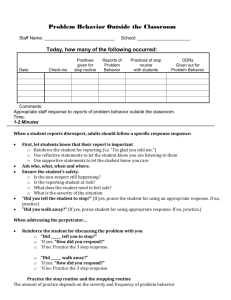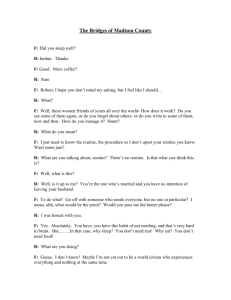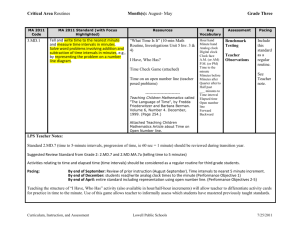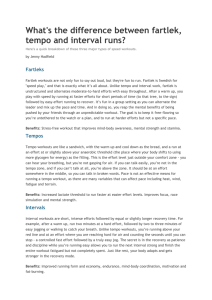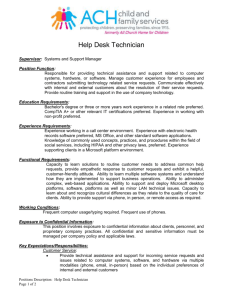Phase: Preparation Phase
advertisement
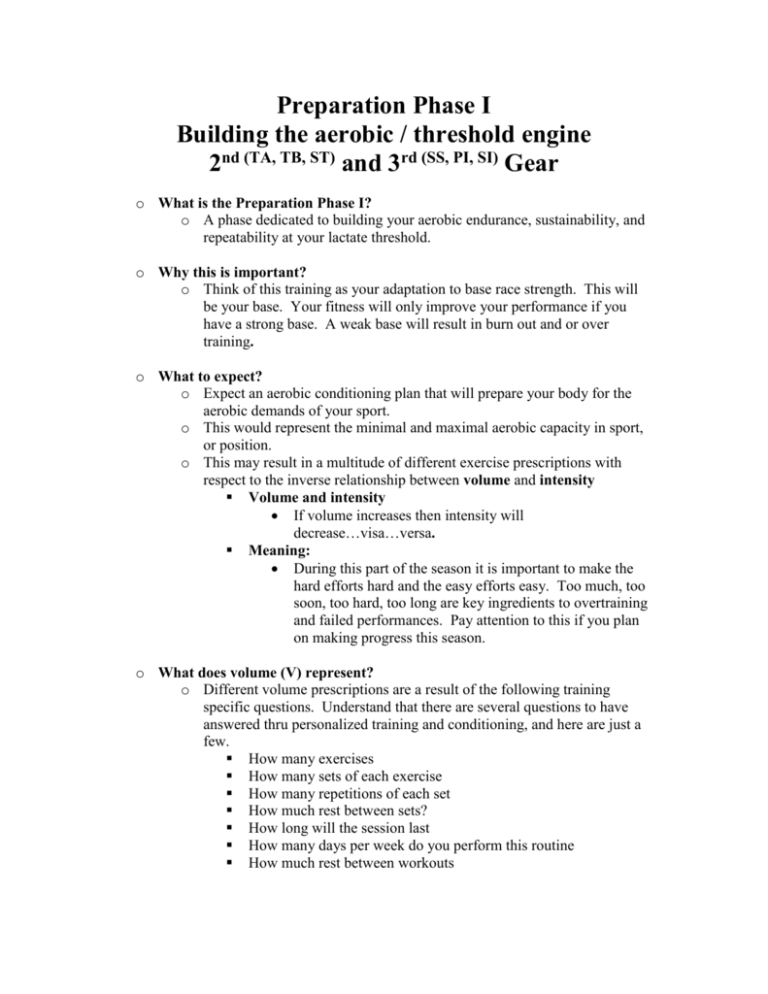
Preparation Phase I Building the aerobic / threshold engine 2nd (TA, TB, ST) and 3rd (SS, PI, SI) Gear o What is the Preparation Phase I? o A phase dedicated to building your aerobic endurance, sustainability, and repeatability at your lactate threshold. o Why this is important? o Think of this training as your adaptation to base race strength. This will be your base. Your fitness will only improve your performance if you have a strong base. A weak base will result in burn out and or over training. o What to expect? o Expect an aerobic conditioning plan that will prepare your body for the aerobic demands of your sport. o This would represent the minimal and maximal aerobic capacity in sport, or position. o This may result in a multitude of different exercise prescriptions with respect to the inverse relationship between volume and intensity Volume and intensity If volume increases then intensity will decrease…visa…versa. Meaning: During this part of the season it is important to make the hard efforts hard and the easy efforts easy. Too much, too soon, too hard, too long are key ingredients to overtraining and failed performances. Pay attention to this if you plan on making progress this season. o What does volume (V) represent? o Different volume prescriptions are a result of the following training specific questions. Understand that there are several questions to have answered thru personalized training and conditioning, and here are just a few. How many exercises How many sets of each exercise How many repetitions of each set How much rest between sets? How long will the session last How many days per week do you perform this routine How much rest between workouts How many maintenance and recovery routines are performed in each phase of training? o What does intensity (I) represent? o Different volume prescriptions are a result of the following training specific questions. Understand that there are several questions to have answered thru personalized training and conditioning, and here are just a few. How many exercises? 3-8 different exercises How many sets? 2-12 Target of this type of training: More specific exercises targeting above threshold efforts At what intensity: At or above 92% of your lactate threshold How will the exercises be used? 6-24 weeks In what way can expect to perform this type of workout: Coupling effects o Ascending intervals o Descending intervals o Pyramid Intervals o Drop sets o Compound sets o Supersets o Simulations Can you perform at or above 95% of your maximal effort? How much rest between sets? How long will the session last? How much rest between workouts? How many maintenance and recovery routines are performed in each phase of training? During this phase of training you should learn the follwing? o Goal or target of the Preparation Phase: o To develop a strong aerobic base that will help you recover from high intensity efforts without “popping your legs”. This training will get you ready for above threshold work and specialized race specific situations or simulations. This is where you develop race specific strength. Rules of the preparation routine are as follows: 1. Routine A1 o 6 sets x 8 min Tempo efforts o Rest between intervals (RBI) = 2 min o Perform this workout 6-8 x before trying routine B Routine A2 o Location: Lookout mountain o Workout: 4-6 x 4 min Steady States o With 10 second speed intervals used at variable times such as: Out of corners Accelerating to gap the field on climbing, descending, and flats. Remember this is an all out effort. The goal is to recover and repeat. You can repeat at consistent intervals or randomly during the set. o Coaching suggestions: Use a high cadence = 105+ In the saddle Work on having a smooth pedal stroke o Rest Between Intervals (RBI): o 2 min, you can descend during this time. By leaving from the same starting point you can see how far you can travel. This maybe helpful as it offers a challenge to every set. Routine A3 Coming soon!!!! Routine B o 8 sets x 8 min Tempo efforts o During the 8 min efforts, perform 3 x 5 second sprints (alternate in and out of the saddle when sprinting. o This effort is best done on a 1 mile lap, where you can sprint out of the corners or turns. You may also utilize positive grade changes to sprint. Think where you will be able to gap the field and set attacks to create separation from the peleton. o Rest between intervals (RBI) = 2 min o Perform this workout 6-8 x before trying routine C Routine C o 4-6-8 x 10 min over - unders o Over - unders are performed by getting to a tempo pace, and then every 2 minutes perform a 30 second power interval (PI), which will push you over your threshold to a submaximal level of field test pace. o After the 30 second PI settle into the lower end of your tempo prescription. o Recover for 2 min and repeat until you have reached 10 minutes. o This exercise is designed to prepare your body to recover at threshold after a very hard effort, thus increasing your tolerance and RECOVERY at and above threshold. o This simulates the accordion effect of racing. o Possessing the ability to close gaps, recover and attack are essential elements of racing, no matter what the arena (road racing, Criteriums, XC mountain biking, track racing, etc.). o Rest between intervals (RBI) = 2 min o 4 x 1 min Power intervals o Rest between intervals (RBI) = 2 min o Perform this workout 4-6 x before you are upgraded to Specialized Training modalities Routine D o 4-8 x 4-20 min Steady State w/ 4-10 x 10-20sec Speed Intervals o This exercise is designed to prepare you body to recover above threshold after a very hard effort, thus increasing your tolerance and RECOVERY during building lactate levels accumulate. o This simulates the accordion effect of road racing, more importantly; it will help with acceleratory strength out of corners in races. o Possessing the ability to close gaps, recover and attack are essential elements of racing o For those of you preparing for the Cherry Creek Time Trial (CCTT). This workout will test you consistency and repeatablility at submaximal work. o This effort should feel like a field test effort. o Rest between intervals (RBI) = 2-5 min o Perform this workout 4-6 x before you are upgraded to Specialized Training modalities Routine E (in preparation for the specialization phase) o Big and Small Gear Sprints Routine F o Power Intervals BAC A-1 – A3: Base Aerobic Conditioning Routines A1-A3 o Intensity: Recovery to Endurance Miles. Jeep it below threshold, be disciplined to do it! o Duration: 2.5-5 hours o How many times: Perform this workout 8-16 x during your time with routine A1A3. o This means you will perform 8 Routine A1 workouts, during the time between harder intensity training days perform 8 Base workouts before attempting Routine B. The same holds true in your progression from B to C. Weight Training o If you decide to weight train try 8 workouts following these rules: o Total workout time 45-60 minutes o Choose 5 exercise below and perform 6-8 sets x 2-8 reps at 85%+ of your one rep maximum. o This would represent 8.5 on a scale of 1-10. o Your tempo should reflect a 2-3 second down phase (eccentric muscle contraction and a 3-4 second up phase (concentric muscle contraction) during the full movement pattern. o Perform this routine 8-12 x, then I will test and prescribe you next phase. o If you do not understand the exercises or have questions regarding form and technique, please contact me to schedule and appointment for a workout. Exercise choices: 1. *Leg press 2. *Squat – advanced movement 3. *Front Lunge – advanced movement 4. Front Squat – advanced movement 5. Overhead squat – advanced movement 6. DB Bentover row 7. Db rear lateral Raise 8. Romanian Dead lifts – advanced movement 9. Russian Leg curls – advanced movement 10. Db or BB bench press 11. Db or BB incline bench press 12. *Transverse Shoulder press (twist and press) – advanced movement 13. Lat Pulldown 14. *Seated cable row w/ Twist (remember to lean forward with the shoulders over knees, during the pull and twist 15. Db shrugs 16. BB shrugs 17. *Side tube walks – Be sure to keep the hips parallel to the ground by lifting the lead foot by only a1/8 of an inch. Keep the abdominal tight 18. Crunches (PSIO ball, mat) 19. Back extensions (PSIO ball, mat) 20. Prone plank Coaches Corner: o By increasing the number of sets you perform, you will become better able to lock in the specific efforts without suffering to maintain for longer durations. The rest o o o o intervals of 2 minutes will challenge you to recover and repeat similar accuracy during your following efforts. The recovery period will change over time, as we begin dialing in specific efforts. The key is consistency, and efficiency. Group rides will be specific to routine A-C. So you may want to try to make the group rides to receive extra coaching on the specifics of the prescribed exercises. I expect you to perform the base workouts in groups on your own time. This will allow us to devote more time to specific training modalities and compliance. Field test will be taken from Time Trials and in 8-12 weeks for those of you that are not participating in the time trial event. Follow your rules of Recovery explained in the excel document Without the proper recovery time you will notice the following: o That your efforts are not as fresh, AND YOU LEGS will feel NOT AS SHARP. o Trouble sleeping well, feeling fatigued. o Decline in performance. o This is the single most limiting factor to you success with the training plan. Without proper recovery, the chance for a strong adaptation to the exercise prescriptions is slim.
